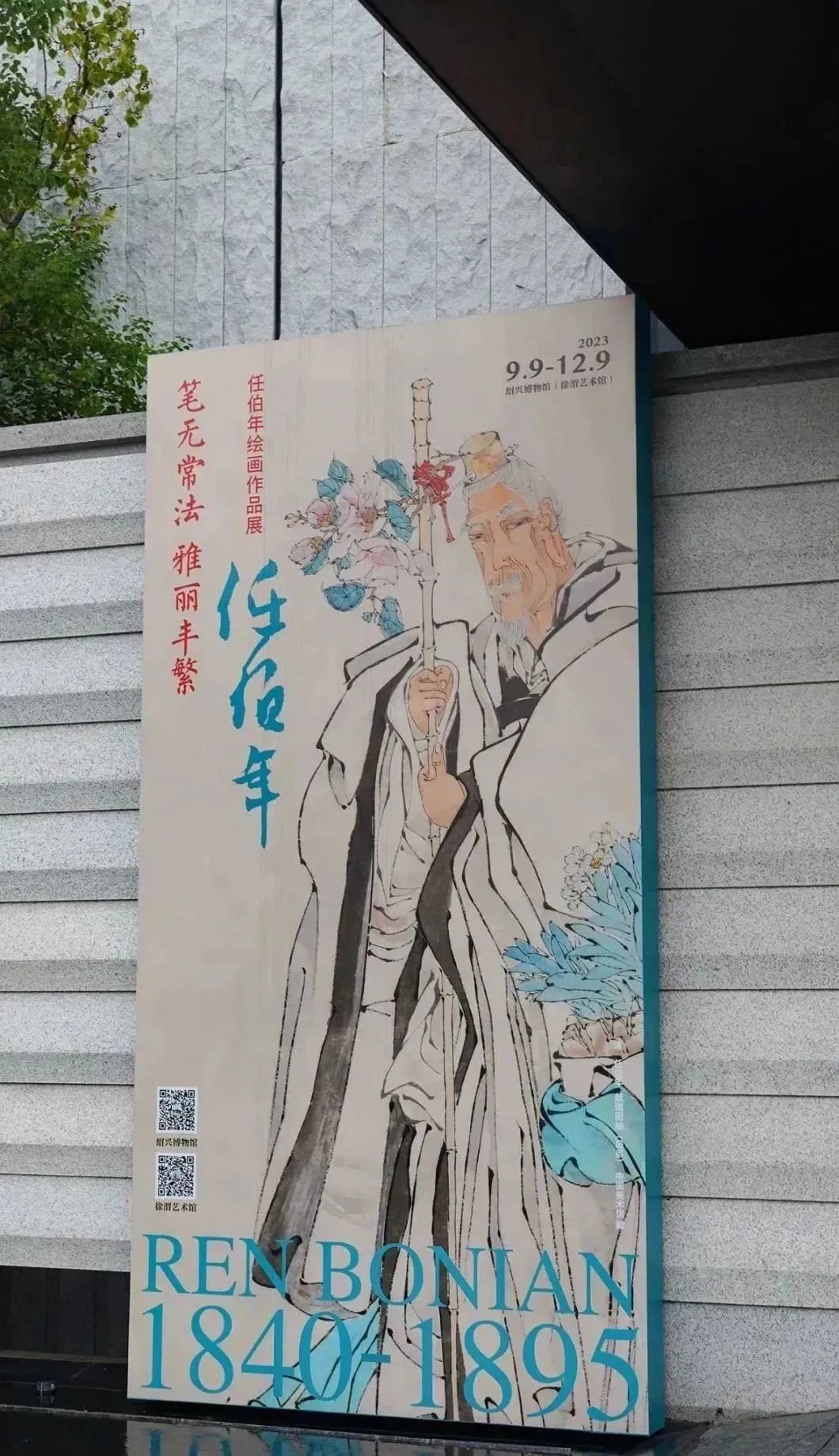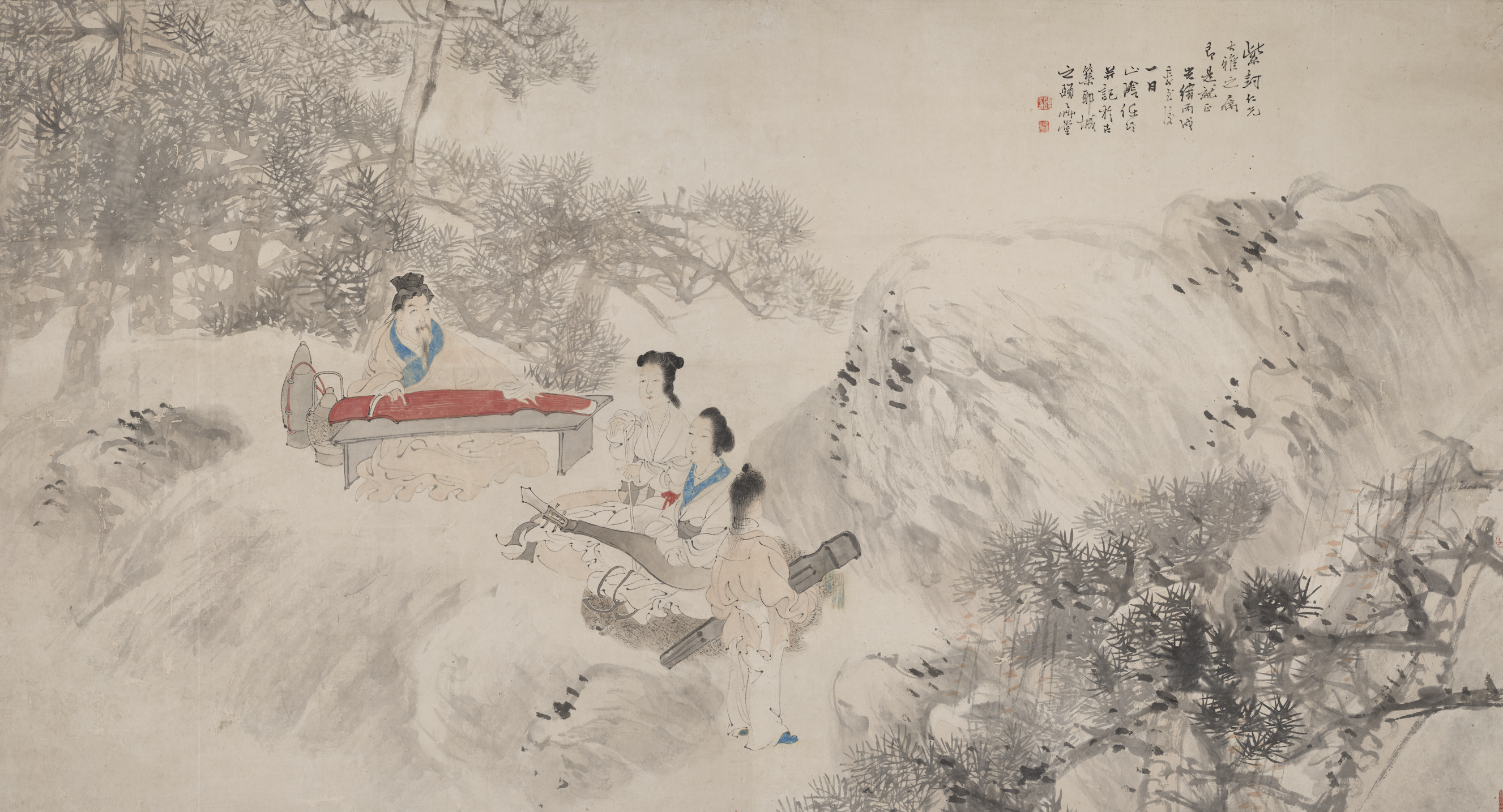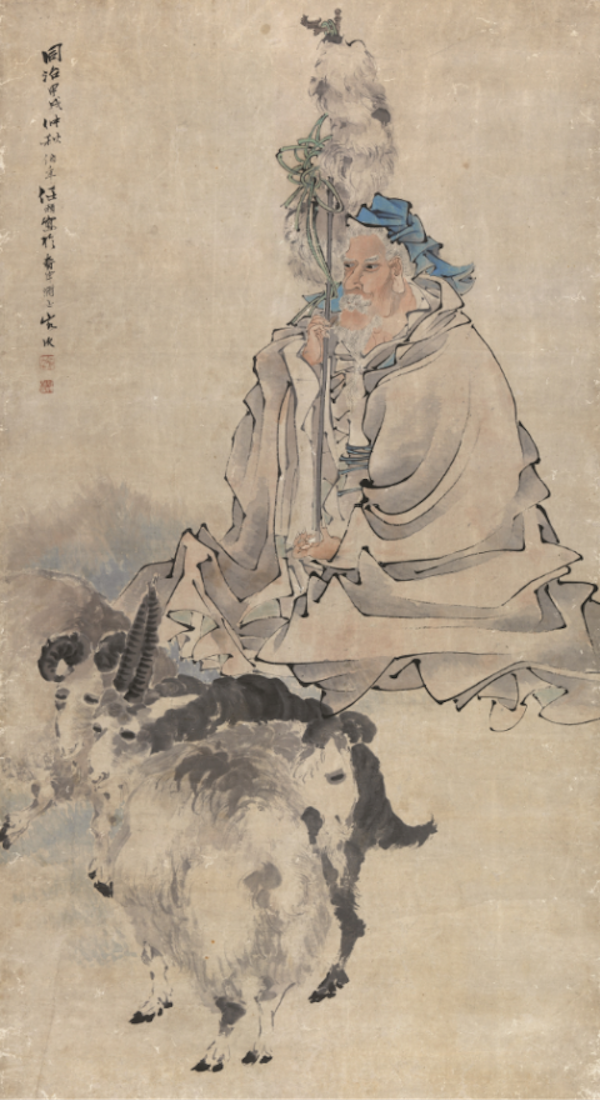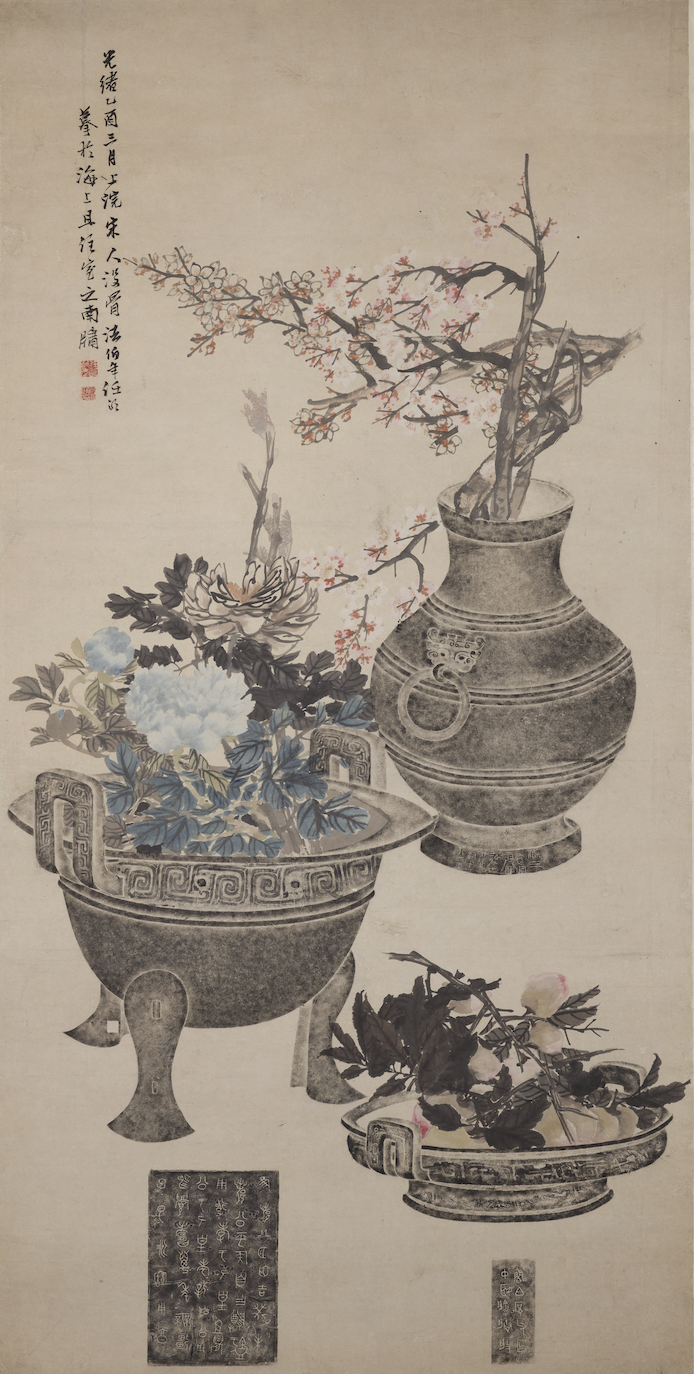
Ren Bonian (1840-1895) was a pioneer in the history of modern Chinese painting and the leader of the Shanghai School in the history of modern Chinese art. Xu Beihong called him "the first Chinese painter after Qiu Shizhou".
"The Impermanence of the Brush, the Elegance and the Richness - Exhibition of Ren Bonian's Paintings" is on display at the Shaoxing Museum (Xu Wei Art Museum) these days (September 9th - December 9th). The exhibition brings together the Palace Museum, China Art Museum 158 pieces (groups) of calligraphy and painting collections from 24 cultural and museum institutions, including the Shanghai Museum, the Shanghai Museum, and the Tianjin Museum, fully demonstrate Ren Bonian’s artistic characteristics and the inclusive, open, and diverse characteristics of Shanghai-style painting represented by him. The Paper published a special issue on the curator of this exhibition, Shen Yiping.
Ren Bonian is a famous painter in the history of modern Chinese art. He was a leading figure among the early Shanghai School painters and created a new situation in Chinese painting in the 20th century. His distinctive artistic style reflects the mood of the times, which is high-spirited and full of vitality. He changed from traditional literati paintings to blindly pursue Lin Quan's exquisite taste. He changed from elegance to vulgarity, making the world unified by ink and wash colorful. He is versatile, has a wide range of themes, full of interest, superb skills, and full of poetry. His vivid, elegant, bright and fresh artistic style is different from Zhao Zhiqian's simple and mao, Xu Gu's Leng Jun, and Wu Changshuo's vigorous. In particular, some of his figure paintings have far-reaching sustenance and gained a very high reputation both during and after his life. Cai Ruohong called him "a master of modern painting" and Xu Beihong called him "the first Chinese painter after Qiu Shizhou", both of which implied the people's appreciation of his works. sexual praise.

Posters at the exhibition

Exhibition site
1. Take advantage of the opportunity of the Asian Games to showcase Shaoxing culture
In September 2023, the 19th Asian Games will be held in Hangzhou, Zhejiang. Shaoxing, as the co-organizer city that hosts the most events, welcomes many domestic and foreign guests. The Shaoxing Municipal Committee of the Communist Party of China and the Shaoxing Municipal People's Government decided to take this opportunity to hold the "Impermanent Brushwork, Elegant and Rich - Ren Bonian's Painting Exhibition" from September 9 to December 9, 2023, to show the ancient city of Shaoxing to the country and the world. The cultural charm of Shaoxing is comprehensively introduced to the art of Ren Bonian, a famous modern Shanghai-style painter in Shaoxing.
2. Select the theme to show your artistic style
Ren Bonian inherited his father's art of painting and portraiture when he was young. As a young man, he has learned from many teachers. He lived in Shanghai and absorbed Western painting techniques. In response to market demand, his works have a wide range of themes and styles, including portraits, figures, flowers and birds, landscapes, etc. Fish, insects, and feathers are omnipotent and capable of everything. Under the circumstances of tight time, heavy tasks and high requirements, it is necessary to properly reflect the "brilliant brushwork" (the name of the National Art Museum of China) of this "giant of the Shanghai School" (the name of the Liaoning Exhibition), and find the appropriate theme to add to this exhibition. An exhibition that comprehensively and systematically introduces Ren Bonian's art is particularly important. It is not only related to the selection of exhibits, but more importantly, whether the exhibition can achieve the purpose and height of comprehensively displaying Ren Bonian's art.

"The pen is impermanent and the elegance is rich - Ren Bonian's painting exhibition" tour guide

"The pen is impermanent and the elegance is rich - Exhibition of Ren Bonian's paintings" Part of the album

Ren Bonian's black cat painting horizontal scroll (detail) on paper, 31 cm in length and 83.5 cm in width, collected by Shanghai Chinese Painting Academy
After researching and listening to expert opinions, this exhibition adopted the theme of "The Impermanence of the Pen and the Richness of the Elegance". The former is a high-level summary and affirmation of Ren Bonian's artistic techniques by his contemporary teacher Xu Gu. "Impermanent method" has different understandings of praise and criticism. Ren Bonian picked up the methods of hundreds of schools of thought and integrated the skills of hundreds of rivers. His personality characteristics are not obvious, and it is difficult to describe his calligraphy and painting level with a certain technical vocabulary. Xu Gu's comment comes from the elegiac couplet mourning Ren Bonian, which praises him for turning nothing into something and turning all laws into his own. Elegant and rich is Xu Beihong's high-level summary of Ren Bonian's artistic characteristics and the significance of the Shanghai School, affirming that his works are suitable for the secular side of all walks of life. The two people’s evaluations were extremely accurate in pointing out the reasons for Ren Bonian’s success and artistic characteristics. This theme of the exhibition is in line with the purpose of comprehensively displaying Ren Bonian’s art, and it is also in line with the Asian Games’ “openness, tolerance, innovation, struggle, enthusiasm, and diversity”. " means.

"The pen is impermanent and the elegance is rich - Exhibition of Ren Bonian's Paintings" is part of Xu Wei's long scroll paintings on display. Collection of the Palace Museum
3. Collect the exhibits from each museum to present the appearance of all kinds of Dharma
The Shaoxing Museum's collection of Ren Bonian cannot fully display the artistic history of Ren Bonian, who brought together hundreds of artists into one family. Following the precedent, the museum has joined hands with 24 cultural and museum institutions in China to collect 158 pieces (groups) of calligraphy and painting collections by Ren Bonian, his teachers, friends, and disciples. From the background of the times, the museum comprehensively displays Ren Bonian's art world and the style of the times.

Part of the album "The pen is impermanent and the elegance is rich - Exhibition of Ren Bonian's Paintings"
The exhibition is divided into "Ren Bonian's life and teachers and friends", "figure paintings that capture reflections like mirrors", "flower-and-bird paintings with exquisite craftsmanship", "landscape paintings with various atmospheres" and "Ren Bonian's life and mentors" based on the categories of Ren Bonian's paintings and the conditions of the exhibition hall. "Artistic Influence" five units.
The first exhibition hall introduces his family background, teachers and briefly describes his extraordinary life. It shows that Ren Bonian followed the Song and Yuan Dynasties in his paintings and learned from Chen Laolian, Shi Tao, Bada, Hua Yan and other great masters. He also learned from the painting styles of the "Three Rens" and "Three Bears" of the same generation, and absorbed folk portraiture and folk art traditions. And the painting characteristics are in line with the needs of the times.

Banner of Dongshan silk and bamboo painting painted by Ren Bonian, collected by Nantong Museum
The second exhibition hall introduces his figure paintings. He inherited his family education at a young age, and under his father's strict requirements, he developed the ability to capture images visually and mentally, laying a solid foundation for portraiture. Later, Ren Bon studied under professional painters Ren Xiong and Ren Xun. The figures painted by Er Ren were based on Chen Hongshou's method, which quickly made them leap to the high ground of figure painting at that time. After living in Shanghai, he adapted to the market and learned Western techniques while absorbing the advantages of various schools, striving to turn all methods into his own. For example, he adopted Bada's center brushwork and changed his gongbi style to freehand brushwork. At the same time, he also integrated the boneless technique of Yun Shouping and the freehand brushwork of Chen Chun and Xu Wei, forming the characteristics of simple and indulgent pen and ink, clear and elegant colors, and concurrent writing. After he mastered the sketching of Western paintings, his figure paintings were often completed in one stroke. Wu Changshuo once saw him painting with his own eyes and was full of admiration: "The pen is flying like flying, the spirit is in it. It is difficult to learn it since it has lost its true meaning." The "Portrait of Wuqing Pavilion", "Portrait of Ren Fuchang" and "Portrait of Ren Fuchang" are exhibited this time. Zhao Xiaoyun's "Portrait of Sitting Alone in Youhuang", "Xi Zhi Loves Goose", "Su Wu Shepherding Sheep", "Dongshan Silk and Bamboo", etc. are his classic works of "learning from the past and adapting to the foreign", and they were also the most popular ones in the market at that time.

Ren Bonian's Wu Qing Pavilion long scroll on paper, 125 cm long and 39 cm wide, collected by Anji County Museum

Paper scroll of Su Wu’s Muyang, 180 cm long, 98.3 cm wide, collected by Tsinghua University Art Museum
The third exhibition hall displays Ren Bonian’s flower, bird, and landscape paintings. Flower-and-bird paintings account for most of Ren Bonian's more than a thousand surviving paintings. In his early years, he was famous for his meticulous painting of flowers and birds. Since the mid-1870s, his technique has shifted from double hooks to a freehand style of painting that is mainly boneless and supplemented by outlines. During this period, he used the techniques of Lu Ji, Tang Yin, Zhao Ji, Xu Xi, Xu Wei, Chen Chun, Yun Nantian, Bada, Shi Tao, Jin Nong, Bian Shoumin, Hua Yan and other masters. For example, he studied Yun Nantian's boneless technique, but emphasized the use of brushes and speed; he studied Hua Yan's emphasis on "colorful" design; he studied the freehand brushwork of Bada Shanren and "Eight Monsters of Yangzhou" but added his own line drawing techniques to create his own style. system, and pushed freehand flower-and-bird painting to a new peak. These exhibits reflect his eclectic skills and the market trends of the time. The titles of these works such as "A Hall Full of Gold and Jade", "Good Luck and Good Luck", "Wealth and Longevity Stone Picture", "Three Yang Kai Tai", "Wealth Along the Road" and "Four Seasons of Peace" may seem vulgar, but in fact they represent a society in which art has moved from the exclusive domain of literati and aristocrats to the public. The progressive trend is not so much a commodity as it is an important historical material in the history of art in modern Chinese society. In the past, those who criticized Ren Bonian's works as "sweet and vulgar" actually still based their evaluation on the standards of literati paintings, unaware of the great changes in the times and the historical significance of the popularization of art. In this regard, Xu Beihong has a keen eye and can be called Ren Bonian's first confidant.
Ren Bonian's landscape paintings are not many. In his early years, he mostly imitated the green landscapes of the Tang and Song Dynasties, imitating the green landscapes of "Little General Li" Li Zhaoming. Later, he learned Shi Tao's brushwork, and his brushwork techniques were similar to Hu Gongshou's. After middle age, he successively learned from Ding Yunpeng, Shen Zhou, Lan Ying, Wuzhen and other eight major schools in the Ming and Qing Dynasties. The beauty of his landscape works lies in the fact that the artistic conception placed on landscapes by literati since the Song and Yuan Dynasties was transformed by him into scenery that everyone can visit, and he used perspective to give traditional landscapes a sense of reality.
The fourth exhibition hall tells the story of Ren Bonian's influence on later generations. The rise of the Shanghai School was a fundamental change in the history of Chinese painting, and Ren Bonian was the benchmark for the Shanghai School. At that time, Ren Bonian "can buy two hundred copper coins for a fan" ("Chen Banding, Wang Xuetao, and Dong Shouping Comment on Ren Bonian"). From the perspective of the history of painting, "Since the maritime ban was lifted, trade has flourished like no other in Shanghai. And those who make a living from inkstones have also come to live in the imperial painting" (Zhang Mingke: "Hansong Pavilion Talks about Art") Ren Xiong , Ren Xun, Zhao Zhiqian, Hu Gongshou, Xu Gu, Pu Hua, Wu Changshuo and Ren Bonian lived in Shanghai, which changed the capital-centered situation of Chinese painting. The situation is very similar to the rise of the Florence and Venetian schools of painting in Italy, where commerce brought great prosperity to art. Therefore, it can be said that without the market of Shanghai School, Ren Bonian’s art would not be widely recognized; without Ren Bonian, the sourness of Chinese literati paintings would not be able to be cleansed. Shanghai-style art truly opened the door for art to society, and its influence continues to this day.
4. Create an elegant atmosphere and promote celebrities in Shaoxing
Ren Bonian is a star painter in the history of modern Chinese art. After living in Shanghai for more than 20 years, he became the leader of the early Shanghai School, and his influence continues to this day. Ren Bonian's painting style embodies the vitality of Shanghai, a commercial city, and is also a symbol of the rise of civil society in modern China. In the formal design of the exhibition, the museum has adopted warm colors and relatively strong contrast tones in terms of color selection and scene creation in response to this feature. The space also creates a lively scene, trying to simulate the environment of the character's era as much as possible. The entrances and exits of the four exhibition halls are led by representatives of Ren Bonian. At the same time, it is supplemented by elements that illustrate that this exhibition is a boost to the Asian Games.
For each unit and key exhibits, we specially add informative auxiliary display boards to remind you of the technical characteristics, source of inheritance, creative background, contemporary significance of the work, especially its impact on local culture. For example, in the 5-meter-high cabinet in the exhibition hall, a display panel is specially added to explain Ren Bonian's figure paintings, pointing out the contemporary significance and local sentiment of his figure paintings. For example, the theme of "Xi Zhi Loves Goose" has been painted by Ren Bonian many times, with various scenes. different. In the two pieces of "Xi Zhi Loves Goose" on display this time, the artist gave Wang Xizhi various images of a scholar and an ordinary person respectively. These details are the expression of the deep essence of the hometown culture. This shows that he has a deeper sense of local affection and intimacy towards Wang Xizhi. Ren Bonian's nickname is "Shanyin Renyi", and his paintings are often titled "Shanyin Ren Yi", which proves that he deeply believes in the culture of his hometown, which is also an important feature of this exhibition.

Ren Yiji's scroll of the Jinqing Dynasty, collected by Tianjin Museum
In short, this museum held Ren Bonian’s solo exhibition for the first time. It was a huge task with many difficulties. With the support of leaders at all levels, especially the assistance of various fraternal cultural and museum units, the mission was successfully completed. In particular, among the 158 exhibits (groups) in this exhibition, there are 27 first-class cultural relics, 32 second-class cultural relics, and 79 third-class cultural relics. The scale is unprecedented and extremely precious. Among them are "Su Wu Shepherding Sheep" and "Peony White Head" from the Palace Museum, "Album of Miscellaneous Paintings" from Shanghai Museum, "Xi Zhi Loves Goose", "Album of Ink Figures and Landscapes", "Portrait of Ren Fuchang" and "Offering Auspicious Pictures" from the National Art Museum of China. Famous works such as "Portrait of Zhou Xian" in Zhejiang Provincial Museum, "Laozi Riding a Bull" in Guangdong Provincial Museum, and "Portrait of Ji Jin Qing Gong" in Tianjin Museum are all on display for the first time. The catalog "Impermanent Brushwork and Rich Elegance - An Exhibition of Paintings by Ren Bonian" released simultaneously with the exhibition once again reflects the museum's exhibition-organizing tradition of practicing exhibitions, learning, and research. We hope that through this exhibition, we can reflect Ren Bonian's artistic career and cultural significance in a relatively comprehensive, systematic and scientific manner, as well as his enterprising mind that embraces all rivers, the artistic characteristics of various schools of thought, the innovative style of the times, and the creative ideas that appeal to both refined and popular tastes.

Ren Bonian's "Gongsun Auntie Dances with the Sword"
Since the Shaoxing Museum held the Shaoxing Celebrities Exhibition, it has always received cooperation and support from outstanding domestic museums. This exhibition serves the Asian Games, and each museum has continued to provide strong support to make the exhibition a success. This article would like to express my most sincere gratitude to each museum. Passionate Asian Games, charming Shaoxing. Under the concept of “openness, enthusiasm, innovation, and diversity” for this Asian Games, we will continue to follow the municipal party committee and government’s strategic plan to improve Shaoxing’s urban taste and cultural height, learn humbly from other fraternal venues, and use high-level exhibitions to promote culture The integration of tourism and tourism promotes the development of Shaoxing’s cultural and museum undertakings.
(The author of this article, Shen Yiping, is the deputy director and researcher of Shaoxing Museum, the curator of Bonian exhibition, and the vice chairman of Shaoxing Calligraphers Association)


